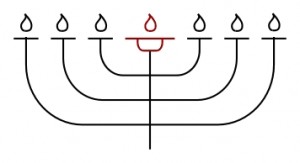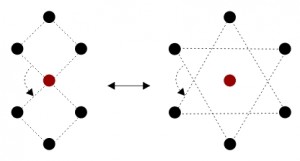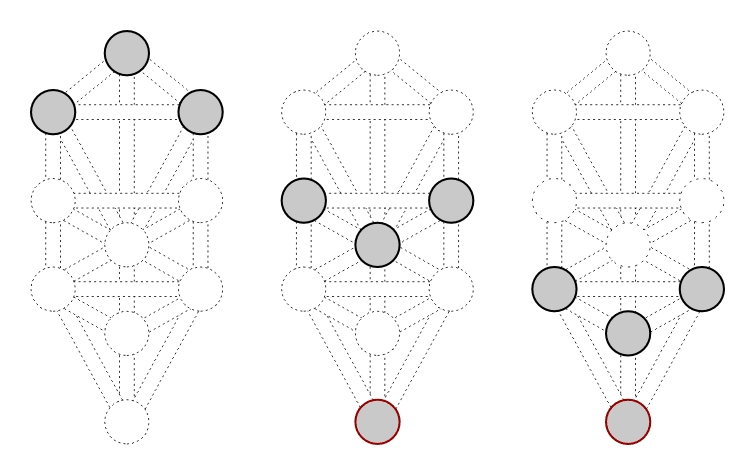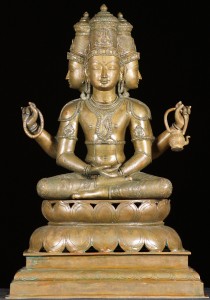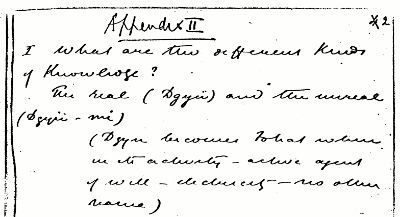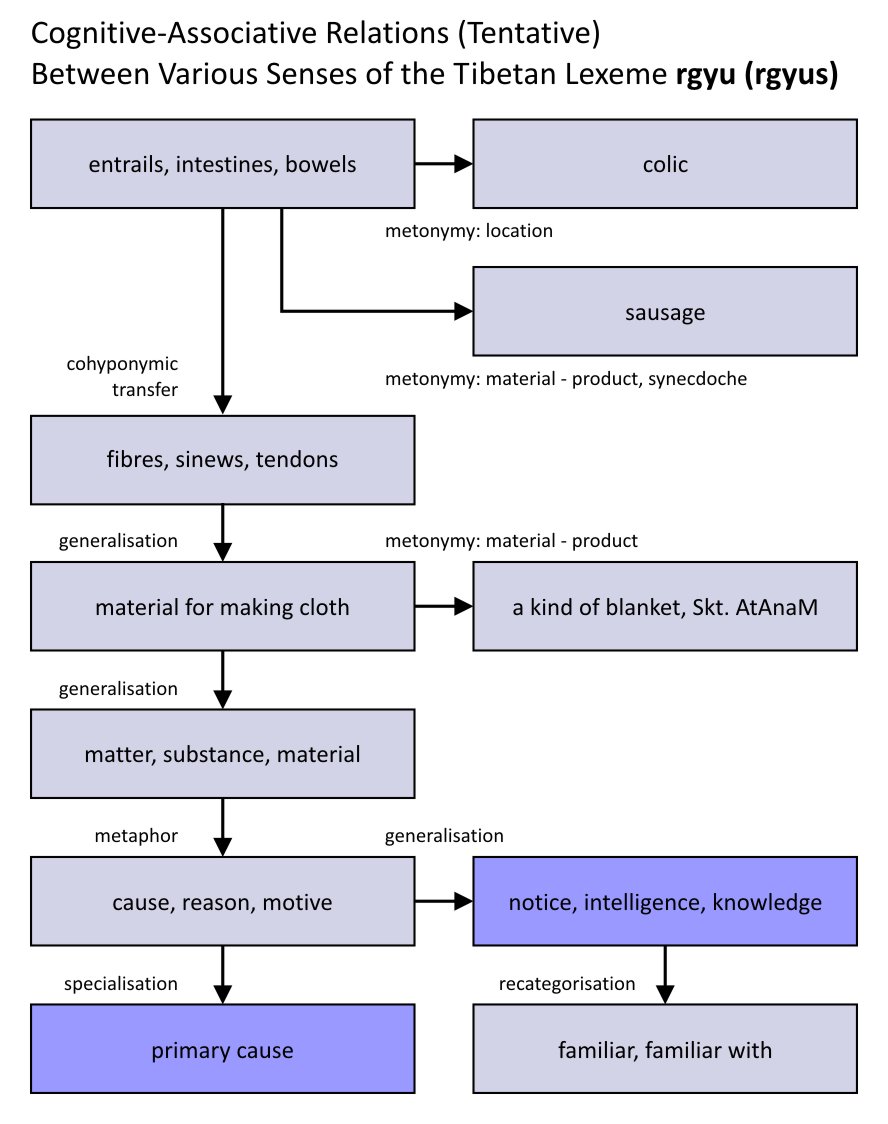“Before the reader proceeds to the consideration of the Stanzas from the Book of Dzyan which form the basis of the present work, it is absolutely necessary that he should be made acquainted with the few fundamental conceptions which underlie and pervade the entire system of thought to which his attention is invited. These basic ideas are few in number, and on their clear apprehension depends the understanding of all that follows; therefore no apology is required for asking the reader to make himself familiar with them first, before entering on the perusal of the work itself.”
(The Secret Doctrine, vol. 1, p. 13)
In this way, H. P. Blavatsky introduced the three fundamental propositions of the Secret Doctrine. When she was later asked by Robert Bowen how to study The Secret Doctrine, she reiterated this, adding the somewhat alarming words, “even if it takes years”: “The first thing to do, even if it takes years, is to get some grasp of the ‘Three fundamental principles’ given in the Proem.”
After reading the first fundamental proposition of the Secret Doctrine, “an omnipresent, eternal, boundless, and immutable principle,” our first reaction might be something like: “That makes sense. Of course. What else would it be?” However, I think that some of the implications of this apparently simple idea may be surprising, and this may explain why it could take years to get a clear apprehension of these fundamental propositions. In order to get these fundamental ideas as directly as possible, and with the least distortion, it will be necessary to quote the primary sources extensively.
“The Secret Doctrine establishes three fundamental propositions:
“(a) An Omnipresent, Eternal, Boundless, and Immutable Principle on which all speculation is impossible, since it transcends the power of human conception and could only be dwarfed by any human expression or similitude. It is beyond the range and reach of thought—in the words of Māṇḍūkya Upanishad, ‘unthinkable and unspeakable.’
“To render these ideas clearer to the general reader, let him set out with the postulate that there is one absolute Reality which antecedes all manifested, conditioned, being. This Infinite and Eternal Cause—dimly formulated in the ‘Unconscious’ and ‘Unknowable’ of current European philosophy—is the rootless root of ‘all that was, is, or ever shall be.’ It is of course devoid of all attributes and is essentially without any relation to manifested, finite Being. It is ‘Be-ness’ rather than Being (in Sanskrit, Sat), and is beyond all thought or speculation.
“This ‘Be-ness’ is symbolized in the Secret Doctrine under two aspects. On the one hand, absolute abstract Space, representing bare subjectivity, the one thing which no human mind can either exclude from any conception, or conceive of by itself. On the other, absolute abstract Motion representing Unconditioned Consciousness. Even our Western thinkers have shown that Consciousness is inconceivable to us apart from change, and motion best symbolizes change, its essential characteristic. This latter aspect of the one Reality, is also symbolized by the term ‘The Great Breath,’ a symbol sufficiently graphic to need no further elucidation. Thus, then, the first fundamental axiom of the Secret Doctrine is this metaphysical One Absolute—Be-ness—symbolized by finite intelligence as the theological Trinity.”
“(b) The Eternity of the Universe in toto as a boundless plane; periodically ‘the playground of numberless Universes incessantly manifesting and disappearing,’ called ‘the manifesting stars,’ and the ‘sparks of Eternity.’ ‘The Eternity of the Pilgrim’ is like a wink of the Eye of Self-Existence (Book of Dzyan.) ‘The appearance and disappearance of Worlds is like a regular tidal ebb of flux and reflux.’
“This second assertion of the Secret Doctrine is the absolute universality of that law of periodicity, of flux and reflux, ebb and flow, which physical science has observed and recorded in all departments of nature. An alternation such as that of Day and Night, Life and Death, Sleeping and Waking, is a fact so common, so perfectly universal and without exception, that it is easy to comprehend that in it we see one of the absolutely fundamental laws of the universe.”
My comment: While no one would doubt that the law of periodicity is true, none of the known systems of philosophy and religion make it a fundamental proposition of their system.
“(c) The fundamental identity of all Souls with the Universal Over-Soul, the latter being itself an aspect of the Unknown Root; and the obligatory pilgrimage for every Soul—a spark of the former—through the Cycle of Incarnation (or ‘Necessity’) in accordance with Cyclic and Karmic law, during the whole term.”
My comment: Take note of the tacit acceptance of the “Universal Over-Soul,” which is by no means widely accepted in the philosophical and religious systems of the East.
“In other words, no purely spiritual Buddhi (divine Soul) can have an independent (conscious) existence before the spark which issued from the pure Essence of the Universal Sixth principle—or the over-soul—has (a) passed through every elemental form of the phenomenal world of that Manvantara, and (b) acquired individuality, first by natural impulse, and then by self-induced and self-devised efforts (checked by its Karma), thus ascending through all the degrees of intelligence, from the lowest to the highest Manas, from mineral and plant, up to the holiest archangel (Dhyāni-Buddha). The pivotal doctrine of the Esoteric philosophy admits no privileges or special gifts in man, save those won by his own Ego through personal effort and merit throughout a long series of metempsychoses and reincarnations.”
(All of the above quotes are from The Secret Doctrine, as edited by Boris de Zirkoff, 1978, pagination the same as in the original 1888 edition, vol. 1, pp. 14-17.)
The implication of this third fundamental proposition is that one cannot attain enlightenment without going through the whole series of rebirths. So the Secret Doctrine does not accept instant or sudden enlightenment, as this is commonly understood in the philosophical and religious systems that teach it. Rather, this third fundamental proposition of the Secret Doctrine makes the gradual or graded path an absolute necessity.
The first fundamental proposition of the Secret Doctrine makes the philosophical doctrine of non-duality or radical unity an absolute necessity. If there is an “omnipresent, eternal, boundless, and immutable principle,” there can be no real plurality. As Blavatsky explained to Robert Bowen (reported by him):
“No matter what one may study in the S.D. [Secret Doctrine] let the mind hold fast, as the basis of its ideation, to the following ideas:
“(a) The Fundamental Unity of all Existence. This unity is a thing altogether different from the common notion of unity—as when we say that a nation or an army is united; or that this planet is united to that by lines of magnetic force or the like. The teaching is not that. It is that existence is One Thing, not any collection of things linked together. Fundamentally there is One Being. This Being has two aspects, positive and negative. The positive is Spirit, or Consciousness. The negative is Substance, the subject of consciousness. This Being is the Absolute in its primary manifestation. Being absolute there is nothing outside it. It is All-Being. It is indivisible, else it would not be absolute. If a portion could be separated, that remaining could not be absolute, because there would at once arise the question of comparison between it and the separated part. Comparison is incompatible with any idea of absoluteness. Therefore it is clear that this fundamental One Existence, or Absolute Being must be the Reality in every form there is.
. . . . . . .
“The Atom, the Man, the God (she says) are each separately, as well as all collectively, Absolute Being in their last analysis, that is their real individuality. It is this idea which must be held always in the background of the mind to form the basis for every conception that arises from study of the S.D. The moment one lets it go (and it is most easy to do so when engaged in any of the many intricate aspects of the Esoteric Philosophy) the idea of separation supervenes, and the study loses its value.”
(“The ‘Secret Doctrine’ and Its Study,” cited from An Invitation to The Secret Doctrine, pp. 3-4)
In The Secret Doctrine Blavatsky had stated this succinctly:
“The radical unity of the ultimate essence of each constituent part of compounds in Nature—from Star to mineral Atom, from the highest Dhyāni-Chohan to the smallest infusoria, in the fullest acceptation of the term, and whether applied to the spiritual, intellectual, or physical worlds—this is the one fundamental law in Occult Science.”
(The Secret Doctrine, vol. 1, p. 120)
The teaching of radical unity or non-duality has been criticized by philosophical and religious systems that do not accept it. They say that if we are all ultimately one, the implication is that we would all already be enlightened. In reply, two levels of truth are posited: one ultimate and one conventional. It is only in ultimate truth that all is one. In conventional truth, where we live our conventional lives, we are obliged to strive for enlightenment over a long series of lives.
The truth of the first fundamental proposition of the Secret Doctrine, that might have seemed so self-evident, becomes much less so when compared with the teachings of other philosophical and religious systems. Thus, an “omnipresent, eternal, boundless, and immutable principle” is greatly at variance with God as taught in theistic religions. God is there usually transcendent, not immanent, as the word “omnipresent” would imply. Even in a non-dualistic system that posits a God who is immanent rather than transcendent, we still have a problem. God as the Creator, or a God that can be prayed to for granting favors, cannot legitimately be described as “immutable.”
How, then, can we legitimately describe this “omnipresent, eternal, boundless, and immutable principle” without using this whole phrase each time? What can we call it with accuracy? The “esoteric Senzar Catechism,” or the “Occult Catechism,” puts the question and answer as follows:
“‘What is that which was, is, and will be, whether there is a Universe or not; whether there be gods or none?’ asks the esoteric Senzar Catechism. And the answer made is—space.”
(The Secret Doctrine, vol. 1, p. 9)
“The Occult Catechism contains the following questions and answers:
“‘What is it that ever is?’ ‘Space, the eternal Anupapādaka.’ ‘What is it that ever was?’ ‘The Germ in the Root.’ ‘What is it that is ever coming and going?’ ‘The Great Breath.’ ‘Then, there are three Eternals?’ ‘No, the three are one. That which ever is, is one, that which ever was, is one, that which is ever being and becoming, is also one: and this is Space.’”
(The Secret Doctrine, vol. 1, p. 11)
Seven years before these extracts from the catechism were published in The Secret Doctrine in 1888, the same thing had been said in the “Cosmological Notes” by the Mahatma Morya in 1881:
“What is the one eternal thing in the universe independent of every other thing?
Space.”
(The Letters of H. P. Blavatsky to A. P. Sinnett, Appendix 2, p. 376)
In the following year, 1882, Blavatsky had explained this in her “Notes” to T. Subba Row’s article, “The Aryan-Arhat Esoteric Tenets on the Sevenfold Principle in Man,” using phrases from the catechism:
“Hence, the Arahat secret doctrine on cosmogony admits but of one absolute, indestructible, eternal, and uncreated unconsciousness (so to translate), of an element (the word being used for want of a better term) absolutely independent of everything else in the universe; a something ever present or ubiquitous, a Presence which ever was, is, and will be, whether there is a God, gods or none; whether there is a universe or no universe; existing during the eternal cycles of Maha Yugas, during the Pralayas as during the periods of Manvantara: and this is Space, . . .”
(H. P. Blavatsky Collected Writings, vol. 3, p. 423)
The consistent use of the term “space” in the primary sources from 1881 to 1888 indicates that this is what the first fundamental proposition of the Secret Doctrine describes as “an omnipresent, eternal, boundless, and immutable principle.” This principle can more simply be referred to as “space.” The question now is: What is space? Is this empty space?
As Blavatsky’s words were reported by Robert Bowen, spoken not long before she died in 1891:
“(b) The second idea to hold fast to is that there is no dead matter. Every last atom is alive. It cannot be otherwise since every atom is itself fundamentally Absolute Being. Therefore there is no such thing as ‘spaces’ of Ether, or Akasha, or call it what you like, in which angels and elementals disport themselves like trout in water. That’s the common idea. The true idea shows every atom of substance no matter of what plane to be in itself a life.”
(“The ‘Secret Doctrine’ and Its Study,” cited from An Invitation to The Secret Doctrine, p. 4)
Blavatsky earlier had written in a footnote to T. Subba Row’s 1882 article referred to above:
“. . . Space filled with whatsoever substance or no substance at all; i.e., with substance so imponderable as to be only metaphysically conceivable.”
(Blavatsky Collected Writings, vol. 3, p. 405 fn.)
In The Secret Doctrine Blavatsky had quoted a secret commentary:
“Extracts from a private commentary, hitherto secret:
“. . . As its substance is of a different kind from that known on earth, the inhabitants of the latter, seeing through it, believe in their illusion and ignorance that it is empty space. There is not one finger’s breath (angula) of void Space in the whole Boundless [Universe]. . . . .”
(The Secret Doctrine, vol. 1, p. 289)
No, it is not empty space. It is substance, imponderable substance, living substance. The following quotes show that this space, this imponderable living substance, is the one eternal thing, and it periodically produces the visible cosmos.
Book of Dzyan, stanza 1, verse 1:
“The Eternal Parent (Space), wrapped in her ever invisible robes, had slumbered once again for seven eternities.”
Blavatsky explains this:
“Space is the one eternal thing that we can most easily imagine, immovable in its abstraction and uninfluenced by either the presence or absence in it of an objective Universe. It is without dimension, in every sense, and self-existent. Spirit is the first differentiation from That, the causeless cause of both Spirit and Matter. It is, as taught in the esoteric catechism, neither limitless void, nor conditioned fullness, but both. It was and ever will be.”
(The Secret Doctrine, vol. 1, p. 35)
Further on in The Secret Doctrine, Blavatsky quotes what is apparently a commentary on the Book of Dzyan:
“‘The ever (to us) invisible and immaterial Substance present in eternity, threw its periodical shadow from its own plane into the lap of Māyā.’”
(The Secret Doctrine, vol. 1, pp. 62-63)
Then later in a footnote, Blavatsky writes:
“‘Creation’—out of pre-existent eternal substance, or matter, of course, which substance, according to our teachings, is boundless, ever-existing space.”
(The Secret Doctrine, vol. 2, p. 239 fn.)
Not only is space described as imponderable living substance, the one eternal thing, it is also called darkness in the stanzas on cosmogenesis from the Book of Dzyan (and once dark space in contradistinction to bright space, stanza 3, verse 7).
Book of Dzyan, stanza 1, verse 5:
“Darkness alone filled the boundless all, . . .”
Blavatsky elsewhere quotes this verse and explains darkness as space:
“This, then, is the meaning:
“‘Darkness alone filled the Boundless All, for Father, Mother and Son were once more One.’
“Space was, and is ever, as it is between the Manvantaras. The Universe in its pre-kosmic state was once more homogeneous and one—outside its aspects.”
(The Secret Doctrine, 3rd ed., vol. 3, p. 180; Blavatsky Collected Writings, vol. 14, p. 186)
Blavatsky then quotes what is apparently a secret commentary, which uses divine substance in place of darkness or space:
“Says the Secret Doctrine:
“It is called to life. The mystic Cube in which rests the Creative Idea, the manifesting Mantra [or articulate speech—Vāch] and the holy Purusha [both radiations of prima materia] exist in the Eternity in the Divine Substance in their latent state
—during Pralaya.”
(The Secret Doctrine, 3rd ed., vol. 3, p. 181; Blavatsky Collected Writings, vol. 14, p. 187)
These three designations of the omnipresent, eternal, boundless, and immutable principle, namely, space, substance, and darkness, are put together in the following quote, which uses primordial matter in place of divine substance:
“Space filled with darkness, which is primordial matter in its pre-cosmic state. . . . and Space is the ever Unseen and Unknowable Deity in our philosophy.”
(The Secret Doctrine, vol. 1, p. 336 fn.)
In the recapitulation of the teachings in the “Summing Up” section of The Secret Doctrine, the centrality of the teaching of the one fundamental substance-principle is stressed:
“The fundamental Law in that system, the central point from which all emerged, around and toward which all gravitates, and upon which is hung the philosophy of the rest, is the One homogeneous divine Substance-Principle, the one radical cause.”
(The Secret Doctrine, vol. 1, p. 273)
So we have seen the terms space, substance or matter, and darkness used to designate the one fundamental principle. Blavatsky’s Mahatma teachers also called it the one element, as did Blavatsky after them:
“However, you will have to bear in mind (a) that we recognize but one element in Nature (whether spiritual or physical) outside which there can be no Nature since it is Nature itself, and which as the Akasa pervades our solar system, every atom being part of itself, pervades throughout space and is space in fact, which pulsates as in profound sleep during the pralayas, . . . (b) that consequently spirit and matter are one, being but a differentiation of states not essences, . . . (c) that our notions of “cosmic matter” are diametrically opposed to those of western science. Perchance if you remember all this we will succeed in imparting to you at least the elementary axioms of our esoteric philosophy more correctly than heretofore.”
(The Mahatma Letters, letter #11, 3rd ed., p. 63; chronological #65)
“Yes, as described in my letter—there is but one element and it is impossible to comprehend our system before a correct conception of it is firmly fixed in one’s mind. You must therefore pardon me if I dwell on the subject longer than really seems necessary. But unless this great primary fact is firmly grasped the rest will appear unintelligible. This element then is the—to speak metaphysically—one sub-stratum or permanent cause of all manifestations in the phenomenal universe.”
(The Mahatma Letters, letter #15, 3rd ed., p. 89; chronological #67)
“If the student bears in mind that there is but One Universal Element, which is infinite, unborn, and undying, and that all the rest—as in the world of phenomena—are but so many various differentiated aspects and transformations (correlations, they are now called) of that One, from Cosmical down to microcosmical effects, from super-human down to human and subhuman beings, the totality, in short, of objective existence—then the first and chief difficulty will disappear and Occult Cosmology may be mastered.”
(The Secret Doctrine, vol. 1, p. 75)
In the earlier Theosophical writings the one element was sometimes referred to as matter, before substance was chosen as a better term than matter:
“. . . the Eastern Occultists hold that there is but one element in the universe—infinite, uncreated and indestructible—matter; which element manifests itself in seven states . . . . Spirit is the highest state of that matter, they say, since that which is neither matter nor any of its attributes is—nothing.”
(Blavatsky Collected Writings, vol. 4, p. 602)
As in Blavatsky’s commentary on Book of Dzyan, stanza 1, verse 1, where she says, “Spirit is the first differentiation from That, the causeless cause of both Spirit and Matter,” so here she says that Spirit is the highest state of the seven states that that matter, the one element, manifests itself in. The idea of ultimate substance or matter rather than ultimate spirit or God was hard for one of the Mahatma’s correspondents to accept. In a forceful reply, Mahatma K.H. makes it clear what they mean by their teaching of the “one life,” saying that “we believe in matter alone”:
“If people are willing to accept and to regard as God our ONE LIFE immutable and unconscious in its eternity they may do so and thus keep to one more gigantic misnomer. . . .
“When we speak of our One Life we also say that it penetrates, nay is the essence of every atom of matter; and that therefore it not only has correspondence with matter but has all its properties likewise, etc.—hence is material, is matter itself. . . .
“Matter we know to be eternal, i.e., having had no beginning (a) because matter is Nature herself (b) because that which cannot annihilate itself and is indestructible exists necessarily—and therefore it could not begin to be, nor can it cease to be (c) because the accumulated experience of countless ages, and that of exact science show to us matter (or nature) acting by her own peculiar energy, of which not an atom is ever in an absolute state of rest, and therefore it must have always existed, i.e., its materials ever changing form, combinations and properties, but its principles or elements being absolutely indestructible. . . .
“In other words we believe in MATTER alone, in matter as visible nature and matter in its invisibility as the invisible omnipresent omnipotent Proteus with its unceasing motion which is its life, and which nature draws from herself since she is the great whole outside of which nothing can exist. . . .
“The existence of matter then is a fact; the existence of motion is another fact, their self existence and eternity or indestructibility is a third fact. And the idea of pure spirit as a Being or an Existence—give it whatever name you will—is a chimera, a gigantic absurdity.”
(The Mahatma Letters, letter #10, 3rd ed., pp. 53-56; chronological #88)
So the unceasing motion of matter or substance that is its life is what they call the one life. Thus, as stated in The Secret Doctrine’s explanation of the first fundamental proposition, we conceive of the omnipresent, eternal, boundless, and immutable principle under two aspects: as absolute abstract space, and as absolute abstract motion. Either of these terms (or their synonyms) may be used to refer to this principle, because they both refer to the same thing. We in fact find both used in the Theosophical primary sources. Nonetheless, we find a clear preference for “space,” as best illustrated in the esoteric or occult catechism, quoted above. The reason for the preference for using space (or its synonyms: substance, matter, darkness, the one element) is that there can be no motion if there is not something to move. The Mahatma K.H. writes:
“Motion is eternal because spirit is eternal. But no modes of motion can ever be conceived unless they be in connection with matter.”
(The Mahatma Letters, letter #22, 3rd ed., p. 139; chronological #90)
The Mahatma Morya had also addressed this in the “Cosmological Notes,” in reply to queries, again referring to motion as the life of matter:
“Your all-pervading supreme power exists, but it is exactly matter, whose life is motion, will, and nerve power, electricity. Purusha can think but through Prakriti.”
(The Letters of H. P. Blavatsky to A. P. Sinnett, Appendix 2, p. 381)
The Mahatma K.H. explained this more fully in the article, “What is Matter and What is Force?,” using the phrase, “matter in motion”:
“Light, then, like heat—of which it is the crown—is simply the ghost, the shadow of matter in motion, the boundless, eternal, infinite space, motion and duration, the trinitarian essence of that which the Deists call God, and we—the One Element; Spirit-matter, or Matter-spirit, . . .”
(Blavatsky Collected Writings, vol. 4, p. 220)
The same phrase, “matter in motion,” was repeated in The Secret Doctrine by Blavatsky:
“. . . we must seek for the ultimate causes of light, heat, etc., etc., in MATTER existing in super-sensuous states—states, however, as fully objective to the spiritual eye of man, as a horse or a tree is to the ordinary mortal. Light and heat are the ghost or shadow of matter in motion.”
(The Secret Doctrine, vol. 1, p. 515)
And matter or substance is always in motion:
“It is a fundamental law in Occultism, that there is no rest or cessation of motion in Nature.”
(The Secret Doctrine, vol. 1, p. 97)
“We say and affirm that that motion—the universal perpetual motion which never ceases, never slackens nor increases its speed, not even during the interludes between the pralayas, or ‘nights of Brahma,’ but goes on like a mill set in motion whether it has anything to grind or not (for the pralaya means the temporary loss of every form, but by no means the destruction of cosmic matter which is eternal)—we say this perpetual motion is the only eternal and uncreated Deity we are able to recognise.”
(The Mahatma Letters, letter #22, 3rd ed., p. 135; chronological #90)
“What things are co-existent with space? . . .
“(iii) Motion, for this is the imperishable life (conscious or unconscious as the case may be) of matter, even during the pralaya, or night of mind.”
(“Cosmological Notes,” The Letters of H. P. Blavatsky to A. P. Sinnett, Appendix 2, p. 377)
Matter or substance is always in motion, even during pralaya or while asleep, because motion is its life. As its life, “the one life,” it is also referred to as its breath, “The Great Breath”:
“‘The Mother sleeps, yet is ever breathing.’”
(The Secret Doctrine, vol. 1, p. 143, apparently quoting a secret commentary)
“This latter aspect [absolute abstract Motion] of the one Reality, is also symbolized by the term ‘The Great Breath,’ a symbol sufficiently graphic to need no further elucidation.”
(The Secret Doctrine, vol. 1, p. 14)
“It is the one life, eternal, invisible, yet Omnipresent, without beginning or end, yet periodical in its regular manifestations, . . . Its one absolute attribute, which is itself, eternal, ceaseless Motion, is called in esoteric parlance the ‘Great Breath,’ which is the perpetual motion of the universe, in the sense of limitless, ever-present space. . . . Intra-Cosmic motion is eternal and ceaseless; cosmic motion (the visible, or that which is subject to perception) is finite and periodical.”
(The Secret Doctrine, vol. 1, pp. 2-3)
“That, which is neither Spirit nor matter — that is IT — the Causeless CAUSE of Spirit and Matter, which are the Cause of Kosmos. And THAT we call the ONE LIFE or the Intra-Cosmic Breath.”
(The Secret Doctrine, vol. 1, p. 258, quoting a secret commentary)
“The ‘Breath’ of the One Existence is used in its application only to the spiritual aspect of Cosmogony by Archaic esotericism; otherwise, it is replaced by its equivalent in the material plane—Motion. The One Eternal Element, or element-containing Vehicle, is Space, dimensionless in every sense; co-existent with which are—endless duration, primordial (hence indestructible) matter, and motion—absolute ‘perpetual motion’ which is the ‘breath’ of the ‘One’ Element. This breath, as seen, can never cease, not even during the Pralayic eternities.”
(The Secret Doctrine, vol. 1, p. 55)
So motion, the unceasing motion of substance or matter, its life, is also called its breath, “The Great Breath,” the breath of the one element. Besides life and breath, this motion was referred to as svabhāva by the Mahatma K.H., and equated with force:
“Their [the Swabhavikas] plastic, invisible, eternal, omnipresent and unconscious Swabhavat is Force or Motion ever generating its electricity which is life.”
(The Mahatma Letters, letter #22, 3rd ed. p. 136; chronological #90)
The word svabhāva means the “inherent nature” of something. For example, heat is the inherent nature of fire. Here, the something that motion is the inherent nature of would of course be the one element, living substance. The inherent nature of living things is to breathe; and substance or matter, the one element, is taught in the Secret Doctrine as living. Its life or breath is its motion, and this is its inherent nature. So motion can be described as the life of the one element, or the breath of the one element, or the inherent nature of the one element. The equation of svabhāva and motion is important for understanding the stanzas we have from the Book of Dzyan, where the term svabhāva [svâbhâvat] occurs seven times.
We here have yet another term used for motion, namely, force. The Mahatma K.H. uses “force” very much like “the force” from the Star Wars movies. It is the sole force in the universe:
“Yes; there is a force as limitless as thought, as potent as boundless will, as subtle as the essence of life, so inconceivably awful in its rending force as to convulse the universe to its centre were it but used as a lever, but this Force is not God, since there are men who have learned the secret of subjecting it to their will when necessary. Look around you and see the myriad manifestations of life, so infinitely multiform; of life, of motion, of change. What caused these? From what inexhaustible source came they, by what agency? Out of the invisible and subjective they have entered our little area of the visible and objective. Children of Akasa, concrete evolutions from the ether, it was Force which brought them into perceptibility and Force will in time remove them from the sight of man.”
(The Mahatma Letters, letter #22, 3rd ed., pp. 136-137; chronological #90)
The Mahatma K.H. had begun the letter speaking of the universal mind, or infinite mind. In the next paragraph he comments:
“. . . the ‘infinite mind,’ which we name so but for agreement sake, for we call it the infinite FORCE . . .”
(The Mahatma Letters, letter #22, 3rd ed., p. 134; chronological #90)
He concludes:
“The world of force is the world of Occultism and the only one whither the highest initiate goes to probe the secrets of being.”
(The Mahatma Letters, letter #22, 3rd ed., p. 140; chronological #90)
In another letter the Mahatma K.H. brings many of these synonymously used but potentially confusing terms together:
“We will say that it is, and will remain for ever demonstrated that since motion is all-pervading and absolute rest inconceivable, that under whatever form or mask motion may appear, whether as light, heat, magnetism, chemical affinity or electricity—all these must be but phases of One and the same universal omnipotent Force, a Proteus they bow to as the Great ‘Unknown’ (See Herbert Spencer) and we, simply call the ‘One Life,’ the ‘One Law’ and the ‘One Element.’”
(The Mahatma Letters, letter #23B, 3rd ed., pp. 155-156; chronological #93B)
The Mahatma K.H. similarly concluded his article, “What is Matter and What is Force?,” by making it very clear that to speak of force or spirit is to speak of matter or substance, because these are in essence not two different things. Whether we speak of space or substance or matter or the one element on the one side, or motion or spirit or force or the one life on the other side, these are only different descriptions of one and the same thing. It is the same one fundamental principle symbolized in the Secret Doctrine under two aspects, the same one eternal element with its unceasing motion which is its life, the one life. The Mahatma K.H. could say that “we believe in matter alone” because spirit is the motion or life of matter or substance. Again stressing the indispensable side of the equation that is usually left out, but which cannot be separated from spirit because the two are one, he here concludes by referring to the one as indestructible matter:
“Therefore do the Occultists maintain that the philosophical conception of spirit, like the conception of matter, must rest on one and the same basis of phenomena, adding that Force and Matter, Spirit and Matter, or Deity and Nature, though they may be viewed as opposite poles in their respective manifestations, yet are in essence and in truth but one, . . . This is why . . . the Occultist . . . claims . . . that Life, whether in its latent or dynamical form, is everywhere. That it is as infinite and as indestructible as matter itself, since neither can exist without the other, . . . ‘Purush’ is non-existent without ‘Prakriti’; nor, can Prakriti, or plastic matter have being or exist without Purush, or spirit, vital energy, Life. Purush and Prakriti are in short the two poles of the one eternal element, and are synonymous and convertible terms. . . . Therefore, whether it is called Force or Matter, it will ever remain the Omnipresent Proteus of the Universe, the one element—Life—Spirit or Force at its negative, Matter at its positive pole; the former the Materio-Spiritual, the latter, the Materio-Physical Universe—Nature, Svabhavat or Indestructible matter.”
(Blavatsky Collected Writings, vol. 4, p. 225-226)
In summary, we are asked to get some grasp of the three fundamental propositions of the Secret Doctrine, before proceeding to the study of the stanzas from the Book of Dzyan. They appear to be simple enough: (1) an omnipresent, eternal, boundless, and immutable principle, symbolized under two aspects: absolute abstract space, and absolute abstract motion; (2) the law of periodicity; (3) all souls are one with the universal over-soul, itself an aspect of the unknown root, and the obligatory pilgrimage for every soul throughout the whole cycle of incarnation.
When we follow this out, comb through the primary sources and put together the references, a somewhat unexpected picture emerges. As expected, we find the teaching of radical unity, or non-duality. Then when we might have expected the one omnipresent, eternal, boundless, and immutable principle to be described as spirit, we instead find it described as space, as substance that is imponderable, immaterial, invisible, indestructible, and most notably, living, as darkness, as the one element, and as matter with its life which is its motion. When this one fundamental principle is symbolized under the aspect of absolute abstract motion, we do find it described as spirit, and as unconditioned consciousness, although more often as the one life, and as the great breath. Here spirit, however, is not something distinct from and above matter, but is only a way of referring to the life or motion of imponderable matter or substance.
Additionally, the motion or life or breath of substance or matter may be called the svabhāva or inherent nature of the one element. This has important philosophical ramifications. The motion of living substance may also be called force, which is the cause of light, heat, magnetism, electricity, and all other such manifestations. Modern science studies these manifestations without being able to reach their invisible cause, super-sensuous matter in motion. The philosophical and religious systems that posit ultimate reality as spirit, or pure consciousness, or the one mind, are seeing only the aspect of the one fundamental principle that is symbolized as absolute abstract motion. According to the Secret Doctrine, they are missing the aspect symbolized as absolute abstract space. There can be no spirit distinct from substance, because the two in our conceptions are actually one and inseparable.
In brief, ultimate reality as taught in the first fundamental proposition of the Secret Doctrine, an omnipresent, eternal, boundless, and immutable principle, is space (Sanskrit dhātu), the one element, imponderable living substance with its motion which is its life.
